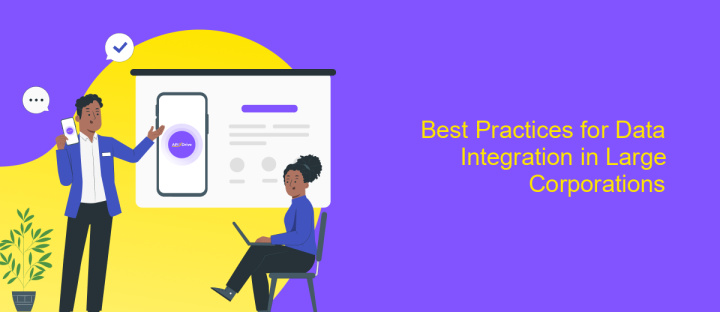Data Integration for Large Corporations
In today's data-driven world, large corporations face the challenge of integrating vast amounts of data from diverse sources. Effective data integration is crucial for making informed decisions, streamlining operations, and gaining a competitive edge. This article explores the strategies, tools, and best practices that enable large enterprises to seamlessly integrate data, ensuring accuracy, consistency, and accessibility across the organization.
Introduction
In today's fast-paced business environment, large corporations face the challenge of managing and integrating vast amounts of data from various sources. Efficient data integration is critical for these organizations to make informed decisions, streamline operations, and maintain a competitive edge. This process involves combining data from different systems, applications, and databases into a cohesive and accessible format.
- Enhancing data quality and consistency
- Reducing operational costs
- Facilitating real-time analytics
- Improving decision-making processes
As corporations continue to grow and evolve, the complexity of their data ecosystems increases. Implementing robust data integration strategies is essential for ensuring that data remains accurate, secure, and actionable. This section will explore key methodologies, tools, and best practices that large corporations can adopt to achieve seamless data integration, ultimately driving business success and innovation.
Challenges of Data Integration for Large Corporations

Integrating data across large corporations presents a range of challenges, primarily due to the sheer volume and diversity of data sources. Different departments often use disparate systems, resulting in data silos that hinder seamless integration. Moreover, ensuring data consistency and quality across these varied sources is a complex task that requires meticulous planning and ongoing management. Data security is another significant concern, as integrating data from multiple sources increases the risk of breaches and unauthorized access.
Additionally, the technical complexity involved in setting up and maintaining data integration solutions can be daunting. Companies need to invest in robust tools and platforms, such as ApiX-Drive, to streamline the integration process. ApiX-Drive offers a flexible and scalable solution that enables automated data transfers between various applications, helping to mitigate some of these challenges. However, the initial setup and ongoing maintenance require skilled personnel, further adding to the operational costs and complexities. Effective data integration thus demands a strategic approach, combining advanced technology with comprehensive governance policies.
Benefits of Data Integration for Large Corporations

Data integration is a crucial aspect for large corporations aiming to streamline their operations and enhance decision-making processes. By consolidating data from various sources, companies can achieve a unified view of their business, leading to improved efficiency and strategic insights.
- Enhanced Decision-Making: Integrated data provides a comprehensive view, enabling better and faster decision-making.
- Cost Efficiency: Reduces redundancy and operational costs by eliminating data silos and improving resource allocation.
- Improved Data Quality: Ensures consistency and accuracy across all data sources, leading to reliable insights.
- Increased Agility: Facilitates quicker response to market changes and customer needs by providing real-time data access.
- Regulatory Compliance: Helps in maintaining compliance with industry regulations by providing a clear audit trail and data transparency.
In conclusion, data integration offers significant benefits to large corporations, from enhancing decision-making to ensuring regulatory compliance. By leveraging integrated data, companies can drive innovation, optimize operations, and maintain a competitive edge in the market.
Best Practices for Data Integration in Large Corporations

Data integration in large corporations requires a strategic approach to ensure seamless data flow and accuracy. Establishing a robust framework is essential for managing vast amounts of data from diverse sources. This involves setting clear objectives and aligning them with the organization's overall goals.
One of the critical aspects is to maintain data quality and consistency. Implementing standardized data governance policies can help in achieving this. Additionally, leveraging advanced integration tools and technologies can streamline the integration process and enhance efficiency.
- Develop a comprehensive data integration strategy
- Implement data governance and quality control measures
- Utilize advanced integration tools and technologies
- Ensure continuous monitoring and optimization
- Foster collaboration across departments
Continuous monitoring and optimization are crucial for maintaining the integrity of integrated data. Regular audits and updates can prevent discrepancies and ensure that the data remains relevant and accurate. By fostering collaboration across departments, large corporations can achieve a unified approach to data integration, driving better decision-making and operational efficiency.


Conclusion
In conclusion, data integration is a critical component for large corporations aiming to streamline their operations and enhance decision-making processes. The ability to seamlessly merge data from various sources not only reduces operational redundancies but also provides a unified view of the organizational data landscape. This holistic approach enables more accurate analytics and reporting, fostering a data-driven culture that can adapt quickly to market changes and customer needs.
Utilizing advanced integration tools like ApiX-Drive can significantly simplify the process of connecting disparate data sources. ApiX-Drive offers a user-friendly interface and robust capabilities for automating data flows between applications, ensuring that data is consistently synchronized and up-to-date. By leveraging such tools, corporations can minimize manual intervention, reduce errors, and focus more on strategic initiatives that drive growth and innovation.
FAQ
What is data integration and why is it important for large corporations?
What are the common challenges faced in data integration for large corporations?
How can large corporations ensure the security of integrated data?
What role does automation play in data integration?
How can a corporation get started with data integration?
Time is the most valuable resource for business today. Almost half of it is wasted on routine tasks. Your employees are constantly forced to perform monotonous tasks that are difficult to classify as important and specialized. You can leave everything as it is by hiring additional employees, or you can automate most of the business processes using the ApiX-Drive online connector to get rid of unnecessary time and money expenses once and for all. The choice is yours!

